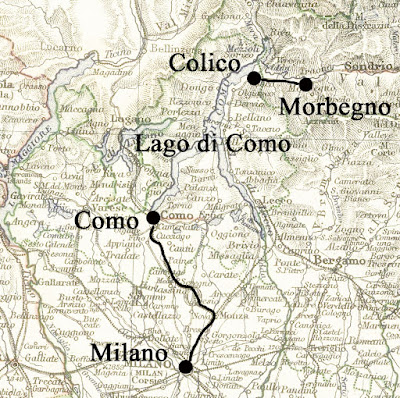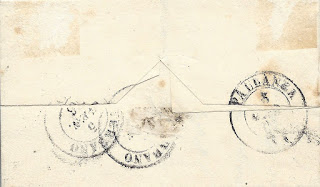Welcome to another edition of Postal History Sunday on the GFF Postal History blog!
Once again, we gather virtually in this blog space and the farmer gets to share something he enjoys with those who might find it interesting. It doesn't matter if you have enjoyed postal history for years or if you just have a passing interest in whatever topics I might uncover for you as I explore. This is a place where we all hope we can learn something new and enjoy the process.
The April winds at the farm have been strong lately, so attach those worries and troubles to the tail of a kite. Once that kite gets up to a height where it is only a speck in the sky - cut the string - and let those things go to the distant parts of the Earth for a time.
--------------------------------
A Book Seller Advertisement in 1863
This
week we'll start with an advertisement for a book store in Milan, in
northern Italy, to Morbegno - which happens to be further north in
Italy.
So, why did I decide I wanted to add this particular item to my collection when I had an opportunity to do so? Well, there are some basic characteristics that drew my attention initially. It was mailed in 1863 in Western Europe, which is the sort of thing I prefer to look at in the first place. The cover itself is pretty clean, with postal markings that I can read. I appreciate the fine details of the postage stamp design. And, there are some contents that add extra interest to the item.
The
inside of this folded piece of paper shows a very simple pre-printed
advertisement for a bookseller who claimed to carry scholarly texts.
The bookseller touts that they have access to books from Libreria
Paravia, a bookshop that opened in 1802 and was still open in 2020,
despite some recent troubles that most brick and mortar bookstores have
faced in recent years.
The cover shows the use of two copes
of the 1 cent centesimi "newspaper" stamp issued by the Sardinian postal
service in 1861. And, this item clearly illustrates the Italian
printed matter rate for that time period (2 centesimi per 40 grams : Jan 1, 1863 - Dec 31, 1888).
And, I was going to pass on it. Why? Well, I don't need more than one example of this printed matter rate in Italy! But, then I looked at the back:
I was sold as soon as I noticed the postal marking at the right. As you know by now, I often hope to find items that open a window or a door to some new (to me) aspect of postal history - and that marking does just that.
Watercraft on Lake Como
The marking in question reads: Natante Como-Colico 16 APR 63 (1)
Postal history has a strong connection to geography because knowing the locations that a piece of mail visited as it traveled from point A to point B can uncover an interesting portion of the story.
As you move toward Switzerland, the Alps dominate the landscape, limiting the the options for travel and the carriage of mail. One of those options would be the deep, elongated lakes - lakes like Lago di Como (Lake Como). Como has a maximum depth over 1300 feet and has a "Y" shape, with one branch coming to the southwest. This branch features the city of Como at its southern-most point. Colico is located near the northern point of the Lago di Como.
This piece of mail was carried by rail from Milano to Como. It was then placed on a Lago di Como side paddle-wheel steamer at Como and the boat traveled north to Colico. It was then carried by some sort of ground transportation to Morbegno.
The steamers Vittoria, Forza and Unione were all active on Lake Como in 1863, but I do not have access to a schedule that would tell me which one carried this particular piece of mail. If I had a guess, I would say that the (1) in the marking probably references the first voyage of the mail steamer from Como that day. Perhaps a specialist in the subject would be able to confirm (or deny) that and perhaps help to identify which ship carried this item?
The Vittoria is shown in the photo below.
So, how did I, a person who does not speak or read Italian (well, maybe a little, tiny bit of the latter) figure this out?
I knew where Como and Colico were. I knew the geography of the region and I didn't know a place called "Natante" nor could I find such a place when I perused period maps of the area. I was also aware of the history of transportation in the Alps and knew there could be some lake travel for mail in the region.
This illustrates two of the benefits that come with internet access for postal historians in the modern world. First, I have access to all sorts of maps that I can view. And, second, I can get immediate help with language translation. It turns out the word “natante” in the postal marking can be roughly translated to “watership.” Aha!
The above section of text was taken from an 1868 copy of Murray's Handbook for Travelers that featured travel to Italy. The route via Lake Como was one of several outlined for the traveler in that book. It is interesting to note that the steamer could go from Colico to Como in 3 1/2 hours (presumably with stops in between).
For those who have interest, this site includes information on Lago di Como steamers. The photo of the Vittoria shown above comes from that site.
Lago di Maggiore / Verbano
To the west lies another lake that provided transportation in the Italian and Swiss Alps using lake paddle steamers. Lake Maggiore holds its northern end within the borders of Switzerland, which gives us an opportunity to look at mail between two countries that was carried by lake mail steamers.
The northern and southern termini of the lake steamer route would be Magadino (Switzerland) and Arona (Italy), but we can actually find mail that got on or off the steamer at other stops on the lake if we are searching.
Shown above is a letter mailed from Roveredo, Switzerland (shown on the map) on March 30, 1864 and received at Pallanza, Italy on March 31. It seems clear to me that this boarded a steamship at Magadino after being carried by land from Roveredo. This letter qualified for the special, discounted border rate between the two nations, so it took only 10 rappen (or centimes) for this letter to be paid to destination. (10 centimes per 10 grams : Jul 1, 1862 - Dec 31, 1875)
Like the prior piece of mail, this one included a hint that told me it was carried on a lake steamer. Can you see it?
The marking to the right reads: Verbano 31 Mag 64 No 2
What
a person has to know is that Lake Maggiore is also known as Verbano.
Once you have that piece of information, it is possible to learn more
about the marking and how this mail traveled.
The other marking is the receiving marking for Pallanza, which is situated on the shores of the lake.
Lago di Maggiore steamers made a circuit of the lake each weekday (and possibly weekend by 1864), with a northbound leg and a southbound leg for each active ship. The Verbano marking includes a number that may indicate which ship carried the mail on that particular day. Later markings often included a direction with “ascendente” indicating the south to north route and “discendente” for the route from north to south.
From the same Murray's Handbook, we can see that the entire trip from Magadino to Arona typically took 4 1/2 hours in 1868.
Another, smaller piece of mail came along for the ride when I found this first item. It also features the 10 rappen border rate and carriage on Lake Verbano/Maggiore.
This
particular piece of mail originated in Brissago, which is on the shores
of Verbano, as well as its destination, Pallanza. Brissago, like many
of the lake communities, still uses water transportation to get to and
from other communities. There is a road that runs next to the edge of
the lake for its entire length in the present day. But, that isn't an
efficient solution if your destination is on the opposite shore.
Once again, if you look carefully, you can find two strikes of the Verbano marking on this folded letter, which identifies it as having been carried on a lake steamer. Sadly, this example is pretty difficult to read, so we can't tell if the ship number is different.
If you like to travel and are able to do so, a person could still ride on a paddle wheel steamer on these lakes. The Piemont (built 1904) can be chartered on Lake Maggiore. On Lake Como, you could find yourself on either the Concordia (built 1927) or Patria (built 1926). But, if it doesn't matter to you if you are on an old paddle-wheeler, there is still public transportation available on both lakes with a fairly complex ferry system.
I wonder if they still put bags of mail on some of them?
----------------------
There you have it! This week's Postal History Sunday entry! I hope you enjoyed your trip to the Alps this week.
And, as usual, I hope you have a good day, a restful weekend and a fine week upcoming.













No comments:
Post a Comment
Note: Only a member of this blog may post a comment.